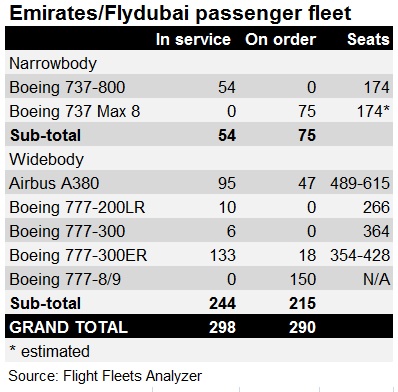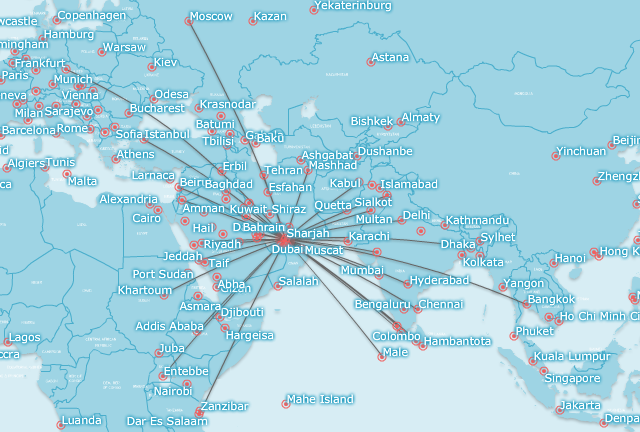News that Emirates and Flydubai are working on closer collaboration – with "nothing off the table" – raises the distinct possibility that the two businesses could merge to create an even more powerful mega-carrier in the Gulf region.
Emirates Airline boss Tim Clark outlined the group's current thinking at the recent Paris air show, pointing out that Emirates flying head-to-head with so much of Flydubai's network "doesn't add to the whole equation" and that work is under way "to accelerate a greater joining at the hip".
He adds: "Nothing's off the table, but with Flydubai we have a short-haul fleet and we can do a better job of making the two work together, and that's what we're going to try. We are owned by the same people."
Not long after its launch in 1985, Emirates began to concentrate on a widebody-only fleet. Currently its lowest-capacity aircraft (other than one Airbus A319CJ) are its 777-200LRs, which have 266 seats. The rest of the fleet seat upwards of 354 passengers, with some A380s configured with a two-class 615-seat layout. The Flydubai Boeing 737-800s seat 174 passengers.
Clark says that the widebody focus at Emirates harks back to its original business plan. "If you roll back to when Emirates first started in the mid-1980s, we were not given access to any regional markets whatsoever, so it shaped our business model," he says. "We went all-widebody long-haul, more by accident than design. But it proved to be a very good business case."
However Clark says that with the dynamics in the Gulf changing dramatically, now "there is a lot of competition and capacity in the single-aisle area… it would be foolish of us to ignore it.
"Compared to the new breed of business model, I'm afraid we are slightly legacy in our approach. And that is the death knell for people like me," he adds. "So we have to adapt our business model to what is going on out there."

Both Emirates and Flydubai are owned by the Dubai government, and the idea of combining the two operations could make good sense. Data from Flight Fleets Analyzer shows that when Flydubai's all-737 fleet is integrated into Emirates' all-widebody operation it would create a carrier with around 300 aircraft in service and a similar number on order. Flydubai operates 54 737-800s and has 75 Max 8s on order.
Such a move is not that radical an idea – both of Emirates' rival Gulf carriers Etihad Airways and Qatar Airways have always operated a mix of single- and twin-aisle aircraft across their networks.
Emirates/Flydubai overlapping routes

FlightMaps Analytics
FlightGlobal schedules data shows that just over a third of Flydubai's 88 routes from Dubai overlap with the Emirates network. It is a curious situation for two airlines owned by the same parent to find themselves in, but Clark says the reasoning that led to the current state of affairs made sense at the time.
"Flydubai was a response to the growth of the likes of Jazeera and Air Arabia [and] the pressures that [Emirates group chairman] Sheikh Ahmed [bin Saeed Al-Maktoum] was facing with regards to carriers [like] Jazeera, which wanted to establish a huge hub in Dubai. Emirates did the original business case and we identified that there was a very good case," he says.
"Unfortunately then there was the financial crisis. Demand tanked and so Flydubai then put itself on top of us in markets that were fairly well established, and that we had built over many years. At the same time, they opened multiple new points which we would never go to – in the 'Stan states, the Russian Federation and parts of Africa."
Clark also points out that Flydubai has "a huge operation" in Saudi Arabia, where it flies to a number of airports that Emirates cannot serve with its widebody fleet because the runway pavement strength is insufficient.
Clark says the exercise to move closer to Flydubai is designed to "to extract greater value for the shareholder where we have an element of competitive forces at play". The move could also unlock important opportunities for the group's network development strategy across the region.
Source: Cirium Dashboard



















